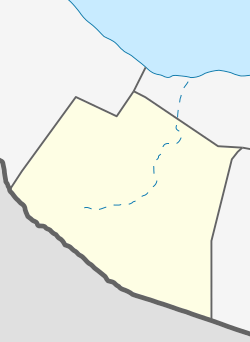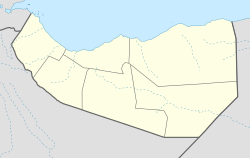|
Gabiley
Gabiley (Somali: Gabiley, Arabic: غابيلي), also known as Gebiley, is a city in the Maroodi Jeex region of Somaliland.[2][3][4] Gabiley is located 58 km west of Hargeisa, the capital of Somaliland. It is in the center of the Gabiley district, bounded on the north by the Gulf of Aden, on the west by the Awdal region, on the east by the Hargeisa district, and on the south by the Somali Region of Ethiopia.[5] EtymologyThe name Gabiley is derived from the Somali word gebi, which can mean either a cliff or a ridge, depending on interpretation.[6] The name reflects the area's unique topography, characterized by its abundance of cliffs and ridges.[6] Situated within the Qalax Valley, the name reflects the geographical characteristics of the area where the town is situated.[6] HistoryGabiley is one of the oldest towns in Somaliland after Zeila, Berbera and Amud. Some stones left behind in the area were believed to have been earmarked for the construction of pyramids. For example Dhagax Gurre situated around 45km northeast of Gabiley and lies about two Hours drive from Hargeisa the paintings are more than 5000 years old. It comprises several individual painted shelters scattered on a rocky hill. The main shelter has an inclined ceiling which is decorated with an assemblage of bovid figures as well as one giraffe and one anthropomorphic figure. The second most important shelter, which lies at the base of the granite outcrop, is adorned with panels representing sheep (or goats) and a few human figures holding a bow. The colours and the complexity of the paintings are much less striking than those at Las Geel, but they’re interesting nonetheless.[7] DemographicsThe town of Gabiley has a population of around 141,000.[1] The Gabiley District in which the city is situated is exclusively dominated by people from the Somali ethnic group, with the Jibril Abokor and Abdalla Abokor sub divisions of the Sa'ad Musa subclan of the Habar Awal Isaaq.[8][9][10][11] EducationPrimary schools, Secondary schools and University education is available throughout the district. The smaller communities have their own primary schools. For post-secondary education, Timacade University was opened in 1999 to serve the needs of the town's students. The education system in Gabiley region is growing in a faster pace than most of Somaliland.[12] Gabiley district has many secondary Schools such as Qalax Secondary, Cigaal Schools, and Al-Irshaad Secondary. The Gabiley National Library opened in April 2021 to provide a suitable space for all Gabiley residents and students to be able to read from the numerous books available. HealthcareGabiley has 6 operating general hospitals. One massive hospital opened in 2010, it provides medical services to the larger region. Gabiley is considered one of the medium-sized district that has a very sufficient medical spacious centers that the population of Gabiley benefits from them and the sustainability of ongoing small private hospitals and clinics have been growing for the last two decades. In 2016 the municipal government was led by Mahamed-Amiin Omer Abdi who is the current mayor of Gabiley city and the governor of Gabiley region.[13] Agriculture Gabiley is the main farm land for Somaliland and produces up to 85% of Somaliland's food supplies. It is known for its agricultural and farming industry, and is where most of Somaliland's crops are produced. Crops grown in the area include apples, oranges, bananas, corn, pears, maize, wheat, barley, beans, lemon, peas, groundnuts, potatoes, tomatoes, onions, garlic, salad and cabbages, broccoli, watermelon, papaya and many other types of fruits and vegetables. Gabiley is considered to be the most fertile region in Somaliland. ClimateAccording to Köppen-Geiger system, Gabiley has a hot semi-arid climate (BSh), although it is moderated by altitude. The average annual temperature is 21.4 °C or 70.5 °F, and the average annual rainfall 489 millimetres or 19.25 inches. June is the hottest month of the year with an average of 24.5 °C or 76.1 °F, whilst January is the coolest with an average of 17.6 °C or 63.7 °F. The driest month is December, with 2 millimetres or 0.079 inches of rain, and the wettest August with 91 millimetres or 3.58 inches. There is a difference of 89 millimetres or 3.50 inches of rainfall between the driest and wettest months. The variation in annual temperature is around 6.9 °C or 12.4 °F.
Notable residents
References
External links
|
||||||||||||||||||||||||||||||||||||||||||||||||||||||||||||||||||||||||||||||||||||||||||||||||||||||||||||||||||
Portal di Ensiklopedia Dunia




